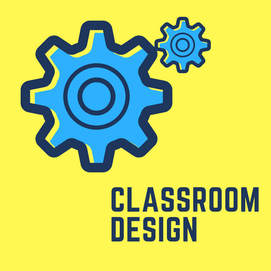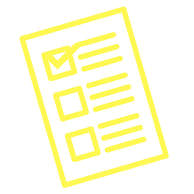 Walking around schools, I still see rows and rows of desks. What? It's not every classroom, but it shows that some of us are still teaching in the 21st century using 20th century design. So if you are one of those row people (I used to be one too), this post is for you. Some of us are willing to jump in and change everything all at once. But perhaps you want to redesign your classroom in more manageable chunks; dip your toe in the water with one or two changes. Whatever changes you hope to implement, I highly recommend thinking them through before students set foot in the door. Classroom design should support learning; it needs to be planned and implemented before the school year begins so that your focus can then shift to building relationships with students, teaching content, creating your classroom community, and fine-tuning your classroom design. Here is checklist of sorts for establishing a more flexible space. You can do all of them, one, or a combination of a few. So bust up the rows and make the 2018-2019 a year of positive change for you and your students. Student seating Keep your student desks if you must (I mean last time I checked schools weren't operating in high clover to buy tables), although I have found tables by trading with other teachers and checking storerooms in the school. I've also gotten good deals at thrift shops on some pieces of furniture. Arrange desks in clusters to allow for collaboration (they can easily be separated for independent tasks). Next, think about levels. Do you have places for kids to curl up, sprawl out on the ground or stand? Another way of thinking about classroom design is offered up by innovator David Thornburg in his work From the Campfire to the Holodeck. He recommends that classroom spaces provide for caves (places for personal learning and reflection), watering holes (places for social gathering where all students can be teachers and or learners in small groups) and campfires (places for whole group gathering, where stories are passed down from elders). This approach resonates with me. And it's easy to make sure you have cozy places for independent work, a space for whole group learning, and spaced for small group collaboration. You can read more here or consider buying his book if you want to delve deeper. Bottom line: just as we offer choice in assignments, we should provide choice in seating for our students. What choices does your space provide for students? Teacher space Where is your own space in the classroom? If you are a BubbleUp Classroom regular, you may know that two years ago, I got rid of my big bulky desk. I don't miss it. The question I get the most -- where do I put my stuff? I have a few color coded bins that I use and a small little cart near my smartboard houses my laptop and a container for pens and pencils. This frees up more space in the room, which can come at a premium in some classrooms. This next school year, I plan to stay desk free, but I am adding a Collaboration Counter (it's a watering hole). This high top table with chairs will be a place for me to do mini-lessons with small groups or for peer tutors to work with classmates. While this is common in an elementary school classroom, it is not a feature often used in middle school. It is vital when designing your classroom to think about where you will be and what message that will send to students. For me, I find that a desk sends out a vibe of separation between teacher and student. I want my classroom to be one that invites collaboration and that includes me -- mixing in with students as much as I can. Classroom Decor During my first year teacher, I had a mentor teacher tell me that I didn't have enough to look at on my walls (and just to be clear there were tons of posters on the wall when she said it). Crushed, I double down on decor - I thought my room had to be full of posters, maps. and signs with inspirational quotes. Eventually, I discarded this veteran teacher's advice as well, wrong. In my view, classes full of decorations distract from learning. My walls are pretty much blank canvasses that I cover only with student generated visible thinking, student work, or student/teacher generated anchor charts. When the anchor chart is not being used it is packed away. Sometimes we use the large whiteboard to answer a question in order to build community. While visual bling might get earn you some compliments, it distracts from the overall goal -- teaching and learning. My one exception is a small bulletin board on my back wall. I invite students to bring in a favorite quote or photo at the beginning of the year, and we create a collage. I explain that I want this room to be their room too. A little piece of home can go a long way in signaling to kids that they matter to me and they should matter to one another. You should also consider color scheme. As a social studies teacher, I was once guilty of decking my classroom out in red, white, and blue. There's a reason people don't decorate their homes in these colors. It's jarring. I've now moved to a softer color scheme of light colors -- mint green, blues. etc. I find that I want to be in a space with calming colors and I also believe that it helps my students with focus and attention issues. You can read more about factors that impact classroom performance here. I think in the end you want something inviting but not overwhelming. Lighting At the risk of starting to sound like an interior decorator, I need to tell you that lights matter. In a modern day classroom you need a vareity of light levels. Bright lights for loud, collaborative learning. Medium light for a more quiet mode and low lights (homey lamps) when you want to create a more quiet, cozy ambiance. Different lessons, different days, require different lighting so consider those options when you are creating your space. And if you are lucky enough to have natural light in your classroom, use it. Studies show that natural light can improve your mood and that of your students. Music is in the Air Sadly, I can't do much to control sound quality in my room (I share a foldable wall with another teacher). But I do what I can using music to foster learning. ambiance. Try creating a few playlists that lend themselves to different lessons (up-tempo for movement), classical for studying or individual work -- you get the idea. If you build these in advance you are far more likely to use them. I recommend Spotify or Pandora -- with a handy remote to mute when the ads come on (I've never splurged for a subscription). I also have colleagues that build playlists based on favorite songs and then kids get to hear their own music. As for air quality, if you have windows you can safely open, do it. Let the fresh air flow even if it's between class changes or during your planning period. Or if you don't have window access, dedicate some of your weekly classroom time to heading outdoors. I often integrate outside walks into our classroom instruction as a brain break. Hunting and Gathering A big part of classroom design is the integration of technology. Take a few moments to be mindful about how your students will be able to access information in your classroom. In keeping with Thornburg's analogy I think of this as hunting and gathering spaces. Do you have ample places for students to hunt and gather information? Computers? Reading nooks? Magazines? Books from a unit available in the room for students who want to dive deeper into topics? Are these places dynamic with new information flowing in as content objectives change? And as a plug for collaborating with librarians, think of your classroom space as expanding beyond your own walls. How can you ensure that your classes will work in library spaces throughout the school year?  Putting it all into practice I think that goal setting is vital to students and teachers alike. I recommend mapping out at least three ways you will alter your classroom design - writing them down -- and then revisiting them throughout the year to see what's working and what isn't. For me, I am likely to stick with what I see. I'd post my goals on paper in a prominent location where I can see them. Perhaps in a planner? Or maybe set a reminder in your phone for check-ins? Lastly, we measure what we value. Consider surveying students to see what they think of your seating and perhaps use their feedback to make changes throughout the year. Flexible seating isn't for the faint of heart. It requires fidelity and feedback to be done right. How do you design your classroom to maximize teaching and learning? What small changes can you commit to making this year in your classroom envirionment? We'd love to hear from you. -Corey You might also like:
0 Comments
Your comment will be posted after it is approved.
Leave a Reply. |
Who We Are
Join our list!Archives
September 2020
Categories
All
|






 RSS Feed
RSS Feed